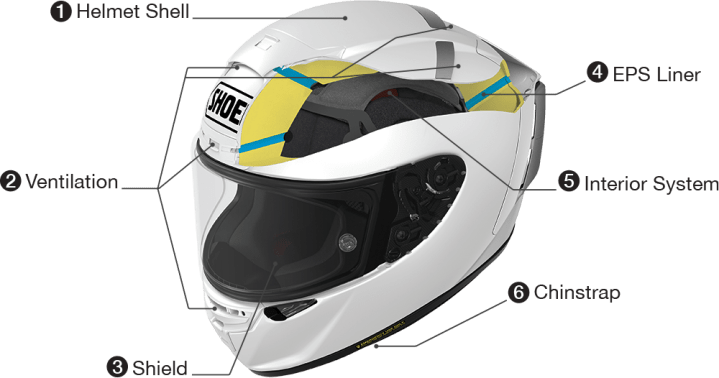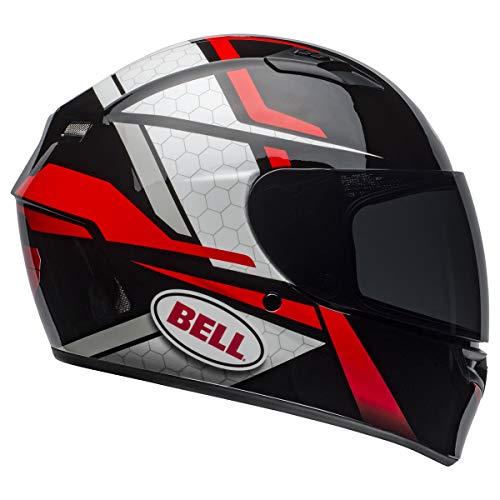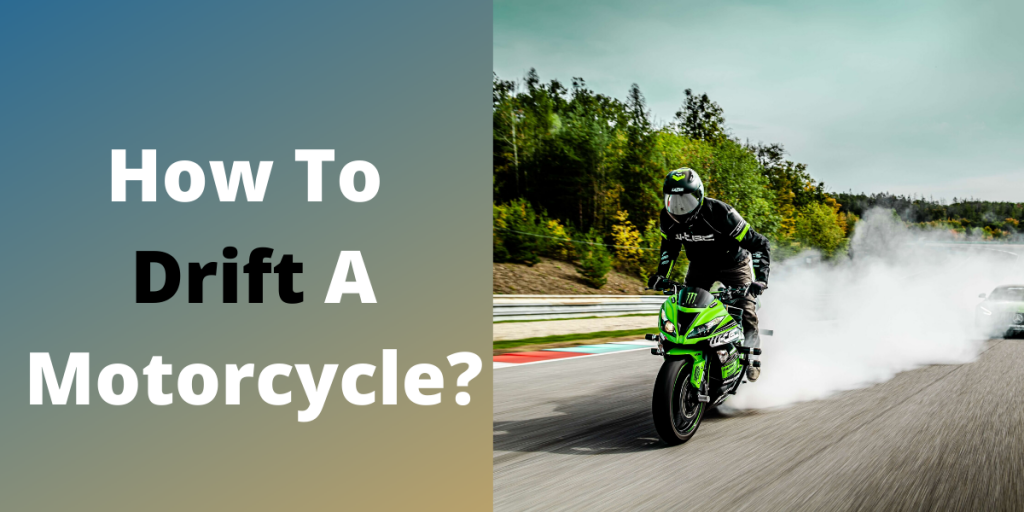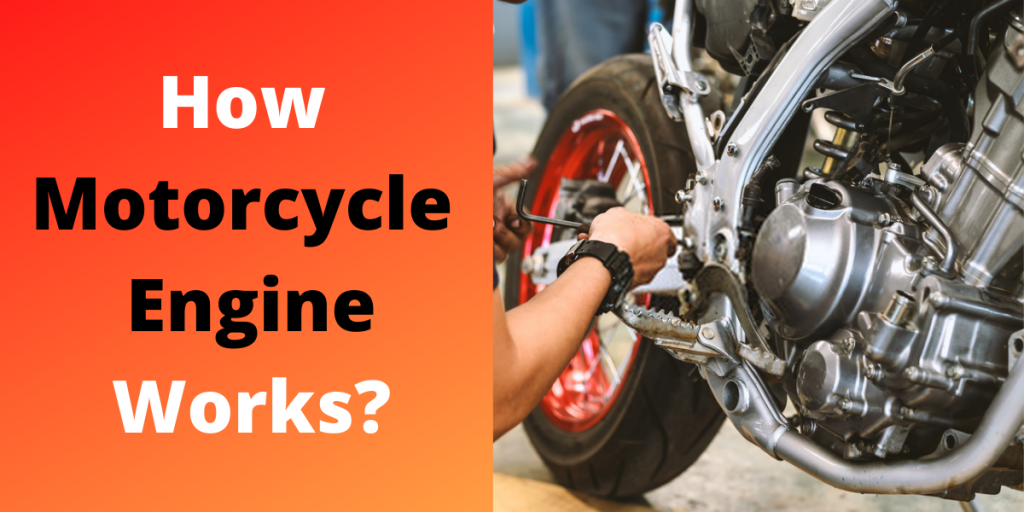Safety comes first, whether you are out for fun, or to get some chores done. If you’re traveling on a bike, you’d better have a motorcycle helmet handy.
A motorcycle helmet’s primary goal is motorcycle safety and protecting the head of the rider during an impact, preventing or reducing head injury, and having saved the life of the rider.
Certain helmets offer extra conveniences, like ventilation, face shielding, ear safety, intercom, and so on.
Through retro football-style helmets to pioneering carbon-fiber and fiberglass, with its 80-year upgrades the motorcycle helmet has built up a lot to transform into the impressive piece of safety and even elegance it is today.
The most significant development in the safety of bikers after the creation of the motorbike itself was the motorcycle helmet. This is the very most important piece of protective equipment for motorcyclists, massively reducing the risk of injury and increasing the chances of survival in a motorcycle crash, as well as shielding them from wind, rain, bugs, dirt, and dust. Nowadays for some riders, motorcycles and their helmets are like two pieces of a single object.

In a healthy motorcycle ride, the helmet is very important. In most countries and states, it’s made mandatory to wear a helmet when riding a motorcycle. To protect their bodies, motorcyclists need to avoid possible risks. The most appropriate thing, to begin with, is by securing the head.
Generally, the head and brain are helpless against injuries in a motorcycle crash. Drivers and riders wearing helmets raise their chances of living by a substantial amount over non-helmet wearers. Motorcyclists must consider the potential dangers of driving bareheaded and without a protective helmet.
Motorists who do not wear a helmet run the risk of a horrific brain in the condition if they’re in a motorbike accident. Without protection, the head is defenseless against a horrible effect in an accident even when going at low speeds.
Structure of a Motorcycle Helmet
The motorcycle helmet has four basic parts: an outer shell, an impact-absorbing lining, a cushioned/padded comfort layer, and a system/chin strap for retention. The basic sections of the helmet each serve a unique need and contribute to securing your head and keeping it secure. Other areas of the helmet are more secure than the safety side, such as the visor/face shield or viewfinder, vents, and cheek-pad.

The Outer Shell
The strong, outer shell of the helmet is the outermost, vibrant component that you see from outside. Typically consisting of carbon fiber, polycarbonate, Kevlar, molded plastics, or a mixture of those substances, its primary purpose is to shield your head in case of impact or skidding and to avoid infiltration from outside items, including rocks, bugs, etc.
Impact Absorbing Liner
The impact-absorbing coating is inside the outer shell, commonly made with EPS (extended polystyrene) material. The primary function of the lining is to absorb the Impact and to displace that force during impact. The outer shell protects foreign objects from invading the helmet whereas the inner layer protects the wearing head from the energy generated from hitting the head by the impact. Some of the layers might be produced from single-thickness foam, while others include a dual-thickness layer (two layers combined) for additional energy dispersion during an impact.
Padded Comfort Layer
It is the area against which your head rests upon while you’re wearing a helmet. It usually consists of an open-cell foam coated in a second piece of cloth, designed to remove sweat and make you feel comfortable while riding. This padding is usually detachable for cleaning and is interchangeable to support different shapes of the head. Consult with the manufacturer of your helmet to see if they provide various comfort liner designs that best suit your head structure.
Retention system or chin strap
The helmet retaining device, also known as the chin strap, is fixed below the chin to hold the helmet on your head when you’re riding. It is made of woven fabric and held in place with two d-rings to keep it secure. When properly positioned, the chin strap will require just 2 fingers between your chin and the strap. For a general rule, the brace is lined with a comparative fabric as a comfort lining to retain sweat and warmth as it rests against the skin.
Types of Motorcycle Helmets
There are 6 fundamental kinds of helmets expected for motorcycling, and others not proposed for motorcycling however which are still used by certain riders. These kinds of helmets are made sure about by a chin strap, and their defensive advantages are extraordinarily diminished, if not completely eradicated if the chin strap isn’t safely attached to keep up a comfy fit. There are a few different helmets for motorcycling but the six major styles of motorbike helmets are full-face, modular, open-face, dual-sport, off-road, and half helmets. They can be detailed as:
1. Full Face Helmets

The full-face helmet gives you the most protection from a potential impact by covering your head and neck both and is considered the safest type of helmets. The safety feature that many helmets don’t have and which differentiates between a full-face and other types of helmets is the chin bar. A study on head injuries on motorcycles and helmet damage showed that the chin is prone to as much damage as the head in case of an impact or an accident and only a full-face helmet can give you that protection of jaw-line and chin.
Wherever or whatever kind of motorcycle you are riding the full-face helmet has a use for a wide set of riders. The riders who ride sports bikes or are professional sports bike riders/racers drive in a knee down position require a helmet which can withstand that angle and does not lift while riding, that’s why they mostly go for a helmet with an elevated chin bar and the visor that starts a little higher and angled towards the top too. On the other hand, travelers, casual riders, and adventure riders usually like to ride in an erect riding position so their helmet has to have a rather straightforward visor and a normal comparatively low chin bar.
Some of the full-face helmets provide you with a vent. It’s a place in the chin bar where the air can come in and out of allowing the air to circulate to cause cooling and evaporation of sweat and significantly reducing for on the visor due to breathing. The vent has also an option to be closed in cold weather so the wind coming in can be reduced. There are other features that have been added to these helmets over the past few years such as Bluetooth speakers, tinted visors that turn dark, and reduced glare during the daytime or in the sun.
2. Modular or flip-up Helmets

Modular or otherwise known as a flip-up helmet is a mixture of a full-face and an open face helmet. It gives you an option to flip up the chin bar and visor of the helmet and convert it to an open face helmet. It also gives you an extra option for an internal tinted visor. This is a permanently tinted visor that you can flip up at the night time and flip-down during the daytime or in sunlight.
The modular helmets are usually heavier than the full face or open face helmets due to their extra functionalities incorporated on that pivot point and in some cases even an extra visor. The safety of the rider may reduce a little as a pivot design is not as strong as one rigid body of the helmet, still because of its extra protection for the chin, it provides more protection than an open face or a half helmet.
It is designed with an erect position in mind that is why it is mostly used by travelers, cruisers, and adventure riders. And as it is for an erect position riding the chin bar sits lower on the helmet and the visor opening is quite straightforward too.
3. Open Face or ¾ helmets

Open face helmets cover your head nicely at the back and the top but it leaves your chin and your face exposed. They are mostly used by scooter riders, café racers, and normal riders as the face area are left open so they can feel the air coming in. The feature that it lacks is the chin bar which compromises the safety of the helmet. Bugs, dust, or even wind to the face and eyes can cause rider distress or injury.
Accordingly, it isn’t phenomenal (and in some U.S. states, is legally necessary) for riders to wear fold overshades or goggles to enhance eye assurance with these protective helmets. Then again, many open face helmets incorporate or can be fitted with, a face shield, which is progressively compelling in preventing flying creepy crawlies from entering the cap.
Open face helmets are thought the same as of a full-face helmet in terms of structure and protection of the area in covers. They are a little light-weighted and it is mainly because of the lack of the chin bar and in some cases even visor but it still does not make that big of a difference in terms of weight. They may be equipped with a partial or even a full face visor to protect your eyes and face from sunlight and dust. And if they do not you can still buy the visor separately.
4. Half Helmets

Half helmets are shaped like military helmets and only cover your head from your eyebrows and the top of your head and give you the very basic protection. Some of them may give some extra protection to your ears and your neck but your face and chin are still left exposed. Unlike open face helmets, it does not support the addition of a visor either. The helmet no doubt gives a great flow of air to your face and head but it provides even less protection than an open face or three forth helmet. They are still approved as motorcycle helmets by the relative authority if you are wondering.
Most of these helmets don’t come with a protective face shield or a visor, for eye protection you might need to purchase riding goggles or glasses. There are a very few technological upgrades that can be made to this helmet due to less availability of space on the helmet. Due to its inferior design language, this helmet provides the least safety and is even considered unsafe by some motorcycle safety foundations as it does not provide any chin protection and apart from the eyes that are covered with the goggles or glasses the whole face is still exposed.
5. Off-road Helmets

The off-road helmet as it is in the name is used for driving “off-road” like in some rough, muddy, or rocky terrain. These types of helmets have a comparatively elongated chin bar and visor area. The face is also left partially opened to give the space for wearing riding goggles and to let the air flow uninterruptedly because this type of riding requires much more breathing.
The visors in this kind of helmets protect the rider from flying dirt and debris even after dipping during off-road riding. It likewise fills the conspicuous need of protecting the wearer’s eyes from the sun. Off-road helmets typically don’t offer eye insurance, so the rider got to have to set up to ride with glasses or goggles. In case you’re riding in soil or mud, goggles will be the better option as they can seal against the rider’s face to keep dust intrusion from the base and sides while riding.
Initially, off-road helmets did exclude a chin bar, with riders using helmets fundamentally the same as current open face helmets, and making use of a face veil to fight off debris and dirt from the nose and mouth. Present off-road helmets incorporate a (usually an angle, instead of round) chin bar to give some facial impact insurance and also protect the face from flying soil and debris.
There are numerous composite choices accessible, including fiberglass, Kevlar, and carbon fiber. These materials offer incredible quality and are lightweight to shield your head and neck from getting exhausted in the wake of a long day of riding. When appropriately joined with goggles, the outcome gives almost equivalent safety features as of a full-face helmet.
6. Dual Sport Helmets

Dual sport helmet gives the best of both of the worlds by mixing the comfort of a full-face helmet with the exterior design of an off-road helmet to provide additional off-road safety. It has an outside styling like an off-road helmet with an enormous visor and lower chin bar, yet offers increasingly inside cushioning and comfort like a full-face helmet.
These helmets work like a hybrid having a larger visor than a full-face helmet, meanwhile, giving the option of snapping it up is you want to use goggles or glasses. The aerodynamics of the visor helps it not lift-up with wind during a ride like an off-road one. The chin bar on this one is thin and not as outward-pointing as the one on the off-road helmet so it is better in damping sounds than letting the airflow in. This combination is the best if you are going through a mixed terrain; out and around on town roads and off-road.
Conclusion
We have discussed the motorcycle helmet and how it has developed over the years. The technological advancements in the field of motorcycle helmets with the installation of Intercom and Bluetooth on them to connect with your mobile phone have been amazing but are more towards comfort than safety. The materials the helmets are made nowadays are strong and lightweight.
The important areas that need protection are your head and brain which cannot deal with a physical impact and can be fatal. Motorcycle helmets are specially made to protect your head the other features it helps you with are included over time as the visor protects you from dust and debris and the chin bar protects your jaw and chin from impact.
Then we saw that how the importance of a motorcycle helmet is almost as much as of having a motorcycle and how there are laws in most of the world that you cannot ride a bike without a helmet. From there we looked at the main components of the helmets i.e. Outer Shell, Impact Absorbent Liner, Padded Comfortable Layer, and Chin Strap. Then we had a detailed introduction to the types of helmets.
Conclusively, it can be said that full-face, the modular, the open face/ ¾, and half helmets are more geared towards riding in town or streets. Meanwhile, off-road and dual-sport are good if you also mix up your street ride with some dirt or terrain. If you pair it up with nice-fitting goggles, off-road helmets as it is in the name are perfect for rough terrain riding.
Undoubtedly! Helmets are the most important safety gear for riding a bike and they should be according to the terrain you ride on so that they also remain comfortable for you.



